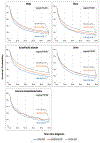Disparities in Hepatocellular Carcinoma Incidence, Stage, and Survival: A Large Population-Based Study
- PMID: 33737301
- PMCID: PMC8172467
- DOI: 10.1158/1055-9965.EPI-20-1088
Disparities in Hepatocellular Carcinoma Incidence, Stage, and Survival: A Large Population-Based Study
Abstract
Background: Liver cancer is one of the most rapidly increasing cancers in the United States, and hepatocellular carcinoma (HCC) is its most common form. Disease burden and risk factors differ by sex and race/ethnicity, but a comprehensive analysis of disparities by socioeconomic status (SES) is lacking. We examined the relative impact of race/ethnicity, sex, and SES on HCC incidence, stage, and survival.
Methods: We used Surveillance, Epidemiology, and End Results (SEER) 18 data to identify histologically confirmed cases of HCC diagnosed between January 1, 2000 and December 31, 2015. We calculated age-adjusted HCC incidence, stage at diagnosis (local, regional, distant, unstaged), and 5-year survival, by race/ethnicity, SES and sex, using SEER*Stat version 8.3.5.
Results: We identified 45,789 cases of HCC. Incidence was highest among low-SES Asian/Pacific Islanders (API; 12.1) and lowest in high-SES Whites (3.2). Incidence was significantly higher among those with low-SES compared with high-SES for each racial/ethnic group (P < 0.001), except American Indian/Alaska Natives (AI/AN). High-SES API had the highest percentage of HCC diagnosed at the local stage. Of all race/ethnicities, Blacks had the highest proportion of distant stage disease in the low- and high-SES groups. Survival was greater in all high-SES racial/ethnic groups compared with low-SES (P < 0.001), except among AI/ANs. Black, low-SES males had the lowest 5-year survival.
Conclusions: With few exceptions, HCC incidence, distant stage at diagnosis, and poor survival were highest among the low-SES groups for all race/ethnicities in this national sample.
Impact: HCC prevention and control efforts should target low SES populations, in addition to specific racial/ethnic groups.
©2021 American Association for Cancer Research.
Figures


References
-
- American Cancer Society. Cancer Facts & Figures 2019. Atlanta, GA: 2019. Accessed September 30, 2020. https://www.cancer.org/content/dam/cancer-org/research/cancer-facts-and-...
-
- Key Statistics about Liver Cancer. Published April 2019. Accessed September 30, 2020. https://www.cancer.org/cancer/liver-cancer/about/what-is-key-statistics.....
-
- U.S. Cancer Statistics Working Group. U.S. Cancer Statistics Data Visualizations Tool, based on November 2018 submission data (1999-2016). 2019. Accessed September 30, 2020. www.cdc.gov/cancer/dataviz.
-
- El-Serag HB, Lau M, Eschbach K, Davila J, Goodwin J. Epidemiology of hepatocellular carcinoma in Hispanics in the United States. Arch Intern Med. 2007;167(18):1983–1989. - PubMed
Publication types
MeSH terms
Grants and funding
LinkOut - more resources
Full Text Sources
Other Literature Sources
Medical

